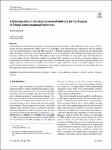Item Infomation
Full metadata record
| DC Field | Value | Language |
|---|---|---|
| dc.contributor.author | Steven, Hayward | - |
| dc.date.accessioned | 2023-04-21T03:22:01Z | - |
| dc.date.available | 2023-04-21T03:22:01Z | - |
| dc.date.issued | 2023 | - |
| dc.identifier.uri | https://link.springer.com/article/10.1007/s10930-023-10113-9 | - |
| dc.identifier.uri | https://dlib.phenikaa-uni.edu.vn/handle/PNK/8193 | - |
| dc.description | CC BY | vi |
| dc.description.abstract | Analysing protein conformational ensembles whether from molecular dynamics (MD) simulation or other sources for functionally relevant conformational changes can be very challenging. In the nineteen nineties dimensional reduction methods were developed primarily for analysing MD trajectories to determine dominant motions with the aim of understanding their relationship to function. Coarse-graining methods were also developed so the conformational change between two structures could be described in terms of the relative motion of a small number of quasi-rigid regions rather than in terms of a large number of atoms. | vi |
| dc.language.iso | en | vi |
| dc.publisher | Springer | vi |
| dc.subject | molecular dynamics | vi |
| dc.subject | Coarse-graining methods | vi |
| dc.title | A Retrospective on the Development of Methods for the Analysis of Protein Conformational Ensembles | vi |
| dc.type | Book | vi |
| Appears in Collections | ||
| OER - Khoa học Tự nhiên | ||
Files in This Item:

